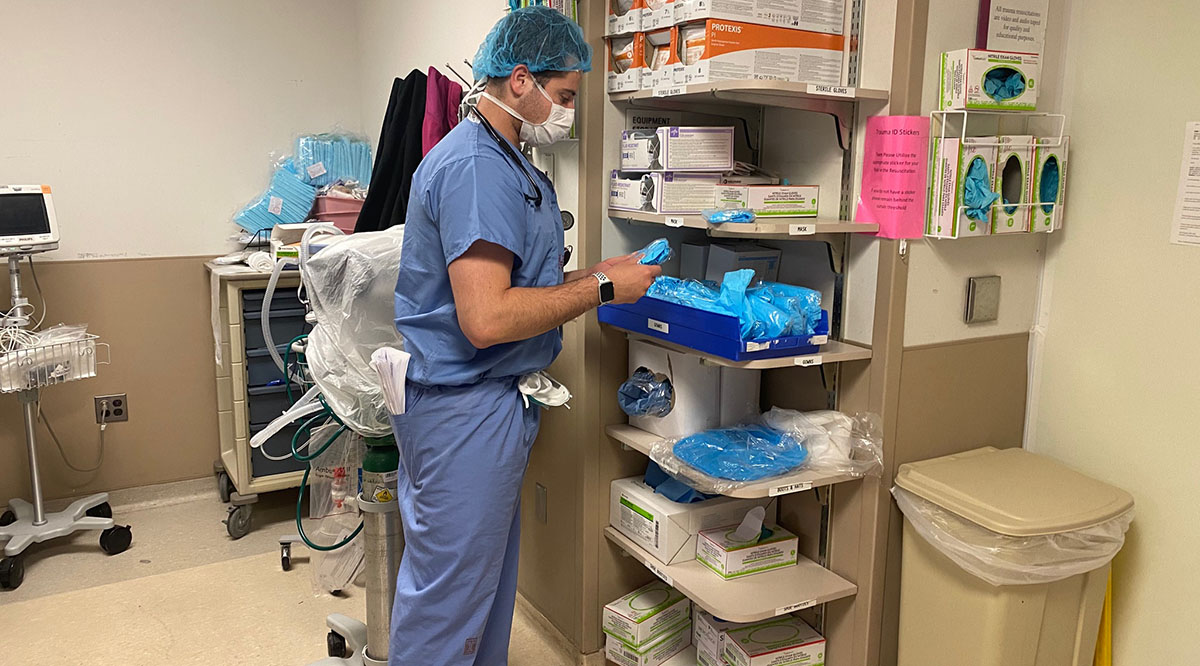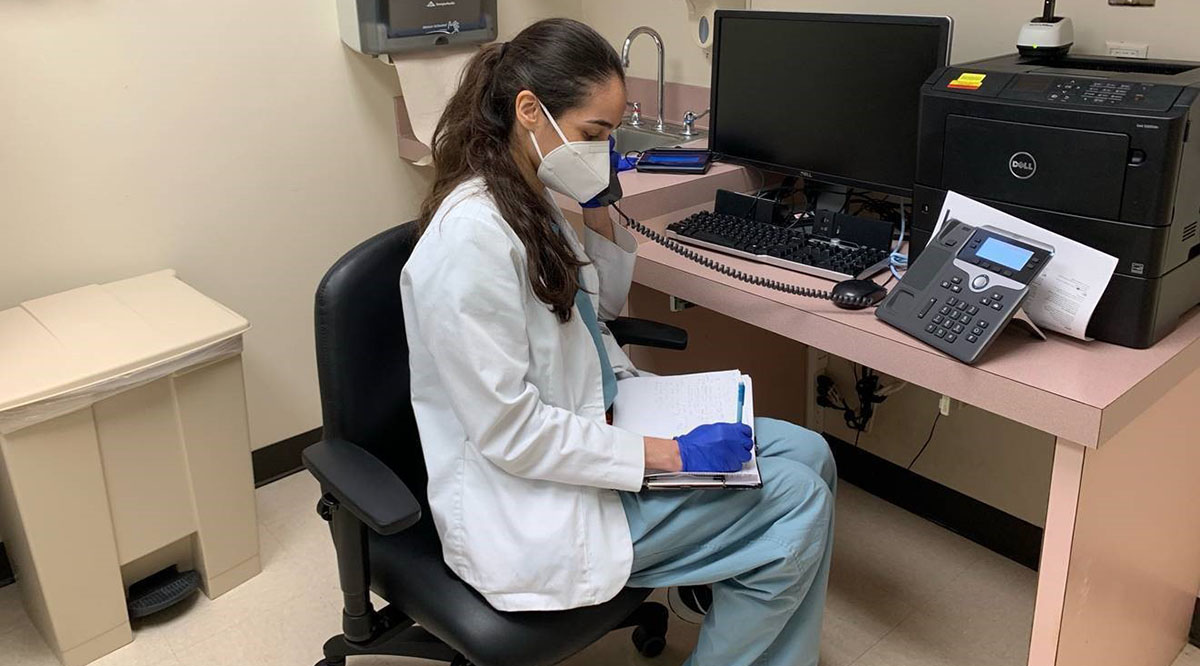
For two months after his clinical clerkship was shuttered to keep students and patients safe from COVID-19, third-year medical student Jake Kieserman took courses online, volunteered at a hospital call center, and kept wishing he could return to patient care. On May 26, the Lewis Katz School of Medicine at Temple University student finally got that chance. And just hours after starting his first shift in his trauma surgery rotation, he was helping save lives.
“We had a motorcycle accident patient whose face was busted up, and I was completely focused on getting the airway clear so the patient could breathe again,” says Kieserman. “After, I thought, ‘Oh, my God, he could have COVID,’ but we are all being as careful as possible and taking extra precautions, including wearing appropriate PPE.”
Kieserman knows he may face increased risk of COVID-19 infection now that he’s back in the hospital. But, he says, “I signed up to take care of people. Medical students enter this field because we want to be out there. We want to help.”
Not all students returning to clerkships will have such a dramatic reentry, but they share similar excitement — as well as some anxiety — about resuming the hands-on training and in-person patient encounters that lie at the heart of clinical clerkships.
“I signed up to take care of people. Medical students enter this field because we want to be out there. We want to help.”
Jake Kieserman
Lewis Katz School of Medicine at Temple University
More than two months after medical schools pulled thousands of students from hospital wards and outpatient clinics because of the pandemic, they are starting to bring students back.
According to a recent AAMC survey, 12% of schools planned to reopen clinical clerkships by the end of May. That total jumps to 50% by the end of June and 68% by the end of July. (Other schools hadn’t finalized their plans yet or didn’t respond to the survey.)
Although schools are restarting clerkships at different times and in different ways, all are pursuing the same goal: keeping learners, patients, and communities safe while teaching vital clinical skills. That means clerkship students find themselves suiting up, providing care, and learning in ways that seem both normal yet also somewhat strange.
“Schools and students have had to adapt in many ways, but we need learners to move through their education so they can be full-fledged members of the medical profession,” says Alison Whelan, AAMC chief medical education officer. “The current pandemic only highlights the great need to ensure that we have a well-trained future workforce.”
Putting together the pieces
For medical schools across the country, figuring out how and when to reopen clerkships is a bit like assembling a jigsaw puzzle in which the pieces are somewhat blurry — and frequently changing, administrators say.
Among the many variables are the level of COVID-19 spread in each community, the availability of faculty, the scheduling of some students into clerkships they need to complete and others into brand-new ones, and standards from the Liaison Committee on Medical Education, which accredits medical schools.
As schools craft their plans, they are turning to certain guiding principles — including those outlined by the AAMC — and making informed guesses about pandemic-related concerns. “As we planned to restart some rotations [in early June], we had to anticipate that we wouldn’t be completely in crisis mode,” says Katherine Nickerson, MD, a clinical director at Columbia University Vagelos College of Physicians and Surgeons in New York.
Like other leaders, Columbia faculty also had to whittle down some clerkships so students can finish all their clinical requirements before the end of their time in medical school. The internal medicine clerkship at Columbia will drop from 10 weeks to eight, for example.
“As we planned to restart some rotations, we had to anticipate that we wouldn’t be completely in crisis mode.”
Katherine Nickerson, MD
Columbia University Vagelos College of Physicians and Surgeons
How will schools pull this off?
Many front-loaded “book learning” so students could plow through didactics while off-campus, freeing up time to see more patients when their clerkships resume. Some of that education was via virtual patients — online scenarios that walk students through the steps of clinical care — and such tools can also help streamline learning back in clerkships.
Baylor College of Medicine in Texas is considering other creative options, such as using webcams to allow returning students to see more patients than usual. “We’re being innovative to guarantee we cover all the competencies students need,” says Jennifer Christner, MD, dean of the School of Medicine. “These steps could actually be better for education in the long run.”
A new normal in a less safe world
Although schools are trying to keep clerkships as “normal” as possible, they’ve implemented various changes designed to keep patients, staff, and students safe as they move forward with education and patient care.
At Baylor, third-year student Yasmin Khalfe had to complete an hour-long training on donning and doffing personal protective equipment (PPE) before heading to her family medicine clerkship last week. She also undergoes a daily temperature check and has to wear a surgical mask all day. She’s just relieved that there’s enough PPE available. “I’m sorry to have been away for long, but I’m glad they had time to figure out how we can be most safe and make sure we have all the necessary resources.”
Alicia Asturias, a third-year University of California (UC), San Diego, School of Medicine student, didn’t anticipate the impact wearing a mask would have on her patient interactions. In fact, she jokes that her eyebrows are working overtime. “Some patients are hard of hearing, and it’s difficult for them to interpret what you’re saying behind your mask. So, I’m using my eyebrows much more to communicate.”
Other students are getting quickly immersed into how to effectively communicate with their patients via telemedicine. In her first week back, Khalfe saw all of her patients via video. “Next week, patients will be able to come to the clinic, but [we’re operating] only at 25% capacity,” she says. “Still, I’m getting to ‘see’ patients on my own, and I’m learning ways I can help even without being with them physically.”
Some educators are cutting down on how many students are present on rounds at the same time to facilitate social distancing and limit the number of possible germ-carriers.
In Philadelphia, Temple medical student Alec Talsania doesn’t work at the same time as the other student doing pediatrics and misses collaborating with peers. “Asking each other questions is a big part of our education, and I’ve learned so much from my fellow students on past rotations,” he says. He also misses some of the rounds that have moved online for now. “It can be a lot easier to ask questions in a small group than to interrupt a 40-person Zoom meeting.”
At UC San Diego, though, students haven’t had to forgo in-person meetings. That’s largely thanks to extensive testing of even asymptomatic individuals. “Students in clinics are being tested just as all our health care workers are being tested,” says Maria Savoia, MD, dean for medical education in the School of Medicine. “We have enough tests, and we’re testing all patients, too. It gives everyone a level of comfort.”
Meanwhile, schools are crafting special considerations for students who are immunocompromised — or live with someone who is.
“Some students are not necessarily going back into the clinical environment,” says Michigan State University (MSU) College of Human Medicine Associate Dean for Undergraduate Medical Education Diane Wagner, MD. “Once we know more about what’s happening in our hospitals and what’s safe, they’ll reenter. It may mean that they’ll face a delay. We acknowledge that we don’t know exactly how it’s going to be for every student.”

One of the biggest safety variables, of course, is whether students will tend to COVID-19-positive patients. So far, the response has been mixed.
For the University of Rochester School of Medicine and Dentistry in upstate New York, the answer was no. “Students are important,” says David Lambert, MD, senior associate dean for medical school education. “But COVID-19 patients will still get great care in the absence of medical student participation. So, why expose more people unnecessarily?”
Columbia decided otherwise. “This disease is devastating, but it’s fascinating,” says Nickerson, adding that she trained at the height of the HIV epidemic. “COVID-19 is going to be with us for a long time, and it’s so important that students learn about it.”
How it feels to be back
Students heading back to clerkships after the pandemic hiatus fall into two basic buckets: those who are happy and those who are happy but also somewhat scared.
“Some people are really excited to start seeing patients again,” says Jalen Dansby, Columbia third-year class president. “Medical students are very goal-oriented, and we were feeling kind of stripped of our sense of purpose. But there’s another group that’s nervous since it’ll be hard to pick up exactly where we left off.”
Just a few days after he restarted his internal medicine clerkship, David Bittner, a third-year student at Rochester, was doing better than he’d anticipated. Still, he says, returning “was a bit of a shock to my system.”
“It takes a lot of practice to learn how to efficiently analyze patient information and then write it up or deliver it orally,” he notes. “I was practicing while I was out, but it’s not the same thing as doing it when you’re under a time crunch at 6 a.m.”
“Some people are really excited to start seeing patients again. … But there’s another group that’s nervous since it’ll be hard to pick up exactly where we left off.”
Jalen Dansby
Columbia University Vagelos College of Physicians and Surgeons
Bittner also feared that there might not be enough educators to support his return. At first, his school had said that nonphysicians might help with teaching if time was too tight for residents. That hasn’t happened, though. “I’m glad about that because residents are mentors who have gone through the same training process and can really relate to us as students,” he says.
Some students may also be worried that overworked staff might not feel particularly excited to start retraining students. But Kieserman was pleasantly surprised by the welcome he received. “My chief resident actually said, ‘Oh, I’m so happy we have a medical student again.’”
Third-year MSU student Glenna Knape, who recently started a neurology rotation, says her predominant feeling was gratitude that she could finally contribute. “I wanted to do anything I could to lighten the workload of health care workers who had been on the front line from the beginning," she says. “It was difficult staying on the sidelines.”
Khalfe says she’s thrilled to be back doing patient care. “I really missed being able to see and help patients,” she says. “The greatest joy I’ve had in my medical school years has been in the clinic, working directly with patients.”
Among the factors propelling Dansby forward is the chance to grow into a physician at a historic moment. “I have concerns, but I realize training now is going to be a once-in-a-lifetime experience,” he says. “It’s going to make our class special. We hope it’s going to help mold us into resilient and courageous physicians and will equip us for any challenges ahead.”
